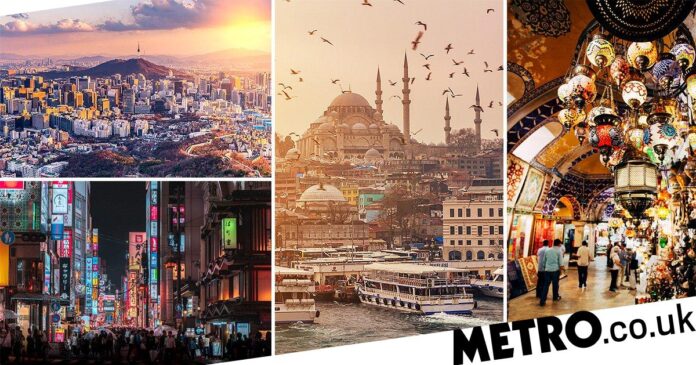Travelling as a disabled person can be challenging (Picture: Metro.co.uk/Getty)
With Covid restrictions almost completely gone, travel is back on the agenda.
And with around one billion disabled people in the world, making travel accessible is essential.
According to The United Nations Convention on the Rights of Persons with Disabilities, public transport should ensure that travel is accessible to disabled people so that they can participate in society ‘on an equal basis with others.’
It is therefore crucial that public transport is accessible for everyone.
But, despite greater awareness around access needs in the face of the pandemic, the situation for disabled travellers remains even more anxiety-inducing than before.
With many barriers – including negative attitudes, lack of assistance and poor infrastructure – travelling as a disabled person can be challenging. And this coupled with cuts to services and staff shortages, makes the situation for disabled passengers increasingly bleak.
Don’t worry, though.
We have new research from the makers of Passenger Assistance, an app that helps disabled people have better travel experiences. They’ve revealed the top city break destinations for travellers with accessibility needs, based on the world’s best transport systems – and the research was inspired by the fully step-free Elizabeth Line.
Larger cities in Asia have set the standard for accessibility (Picture: Getty Images)
Jay Shen, founder of Passenger Assistance, says that larger cities in Asia have set the standard for accessibility, while some smaller European cities offer good accessibility on a more modest scale.
This is because older rail networks – such as those in Paris, New York City, London, Glasgow and Beijing – have the biggest opportunity for improvement, with Paris only having nine out 303 stations with step-free access, according to the research.
Unfortunately, for destinations closer to home, the situation isn’t quite as positive for travellers with access needs. The London Underground and Glasgow’s Subway systems were two of the lowest ranked systems for accessibility – with the total percentage of accessible stations at 33.4% and 13.3%, respectively.
‘While buses, trams and trains typically offer reasonable levels of accessibility, Metro systems are often the best way to explore a city like a local,’ a representative for Passenger Assistance explains.
‘But sadly, many urban Metro systems with underground sections leave much room for improvement.’
Jay adds: ‘In global terms, the London underground definitely has room for improvement if it wants to be the leader in accessibility as only a third of its stations meet modern requirements for accessibility.’
However, nine cities topped the list of accessible destinations, based on 100% step-free access to public Metro systems, with four in Asia and five in Europe.
Top nine accessible cities:
Seoul
Seoul Metro, found in the capital of South Korea, was built in 1974 and has a total number of 622 stations. Access to each station is 100% step-free.
The capital of South Korea (Picture: Joop)
Shanghai
The Shanghai Metro line, in China, was built in 1993 and has 345 step-free stations.
The station was built in 1993 (Picture: King of Heart)
Osaka
Osaka Metro in Japan is home to 133 100% step-free stations along its central line.
A vibrant city (Picture: Martin Falbisoner)
Kuala Lumpur
The Rapid KL line, found in Malaysia’s Kuala Lumpur, boasts 104 stations with step-free access.
An exciting place to visit (Picture: Walkerssk)
Istanbul
The largest city in Turkey has a total of 107 step-free stations along its central Metro, which was built in 1989.
It has 107 step-free stations (Picture: Alexxx Malev)
Oslo
Oslo, the economic and governmental centre of Norway, has 101 step-free stations.
It has unique architecture (Picture: Getty)
Vienna
The Vienna U-Bahn line has 98 step-free stations.
Stunning historical buildings (Picture: kolderal/Getty)
Copenhagen
The Copenhagen Metro line, built most recently in 2002, is only home to 39 step-free stations.
Colourful buildings along the harbour (Picture: Scott E Barbour/Getty)
Helsinki
As the capital of Finland, Helsinki is a picturesque urban centre that hosts 25 step-free stations along its main Metro line.
A beautiful destination (Picture: Miemo Penttinen/Getty)
Do you have a story to share?
Get in touch by emailing MetroLifestyleTeam@Metro.co.uk.
MORE : ‘It’s like we’re an inconvenience’: Disabled people share the accessibility problems they face at festivals – and what needs to be done
MORE : The top 10 most accessible UK walking trails
MORE : Accessibility is about much more than lifts and ramps
Get need-to-know travel news, inspiration and advice from Metro every week.
Sign up here…
Escape the ordinary and discover the extraordinary! From bustling cities to serene landscapes, every journey begins with a single step—let us guide yours. Enjoy curated itineraries, hidden gems, and hassle-free bookings designed for explorers at heart. Whether it's a weekend getaway or a globe-trotting adventure, your Next unforgettable experience is just a click away.










